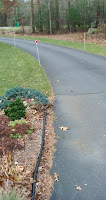 |
Before we 'downsized': a 14-foot
behemoth in our Great Room |
In the continuing debate over artificial versus fresh-cut Christmas trees, we have always been squarely in the ‘real tree’ camp (
see ‘Oh Christmas Tree’, December 16, 2009). The idea of a plastic, made-in-China tree was deemed too repugnant to even consider. In addition to being an affront to our gardening ethos, Betty and I buttressed our beliefs with a near-religious fervor by reading and quoting aloud the statistic that one would have to use an ersatz tree for twenty years for it to have the same carbon footprint as twenty trees from a Christmas tree farm.
And so, with such strongly stated preferences, we are braced for some cognitive dissonance and a few arched eyebrows when guests walk into our home this year and find a nine-foot-tall tree that just happened to have come in a box with assembly instructions. We are also expecting mild sense of bewilderment when those same guests encounter a seven-foot Fraser fir in a different room of our house. One house, two adults, no kids. Two trees?
An explanation is required. And so, one follows.
 |
The interloper: a nine-foot artificial tree,
but your can hang ornaments anywhere. |
We had made a decision last year that we would ‘downsize’ our trees this year. No more fourteen-foot behemoths. No more standing on eight-foot ladders to decorate. No more guy wires to foil curious cats. We would have a sensible tree in 2010. But we are also deeply tied into a celebration called ‘the Festival of Trees at Elm Bank’ which raises money for the Massachusetts Horticultural Society. We helped plan the event and gladly served as volunteers for it. Moreover, Betty was responsible for decorating something like nine sponsored trees.
All entries for the Festival of Trees are artificial, which may seem a bit off-putting given that ‘horticulture’ would seem to exclude things made from hydrocarbons in Asian factories. The trees are artificial because the Festival is held indoors and the local fire marshal read us the fire code: no combustible cut trees indoors where lots of people would assemble. So, an organization that promotes horticulture put fifty-plus artificial - albeit beautifully decorated - trees in a building and people came in droves to see them.
They also came to win those trees. The Festival makes money two ways: a modest charge to get in to see the trees for adults, and the opportunity to buy raffle tickets for those trees once inside. The raffle tickets are where the real money is: once the kids (who are admitted free) see a tree festooned with Hot Wheels cars or pictures of adorable, adoptable cats and dogs or stuffed animals… and, as might be expected, wallets open up and the boxes at the bases of trees fill up with raffle tickets.
I spent many hours at the Festival as a volunteer and I came to admire many of the trees. And so I purchased a couple of sheets of raffle tickets. So, apparently, did Betty. When the Festival closed and tickets were drawn, we found to our surprise that we had won a tree – one of those big nine-footers.
We brought it home and set it up in our ‘great room’ with its 18-foot ceilings. It looked, well, artificial. But we decided that we would use it for at least this one year. It is our custom that our tree gets decorated one week before Christmas – no sooner – and comes down on New Year’s Day – no later. The tree sat, bare, in the room for a full week as we got used to its presence. Then, last Thursday, we made the determination that we also needed a fresh tree. We found a nice, seven-foot Fraser fir at Weston Nurseries, brought it home and set it up in our living room.
 |
The winner and still champion: a
Fraser fir in the living room. |
We’re fortunate that we’ve accumulated a lot of ornaments over the years. Many have come from our travels, some have been handed down from Betty’s parents, more than a few are
objets trouve; things that were never intended as ornaments but that look quite nice on the tree and remind us of people or places past. It turns out that there were more than enough ornaments to decorate two trees.
And so, for this year, the two trees co-exist. I will readily admit that the artificial tree is easier to decorate. Ornaments can be hung without regard to weight anywhere on the tree. Branches can be moved a few inches to accommodate long or short ornaments. And, the dark green color makes every ornament ‘pop’. It is, on the whole, an enticing prospect: a tree that never sheds and drinks no water. A tree that stood straight in its ‘stand’ on the first try and has no holes that must be covered by sleights of hand.
But our hearts are with the Fraser fir in the living room, and that is the tree that will have presents under it on Christmas morning. It has a lovely scent and a serenity that the one in the great room will never touch.
We have been tempted and we have resisted. Come New Year’s Day, the Festival of Trees will have a spare tree to decorate in 2011. It was nice, but we prefer reality.

















































